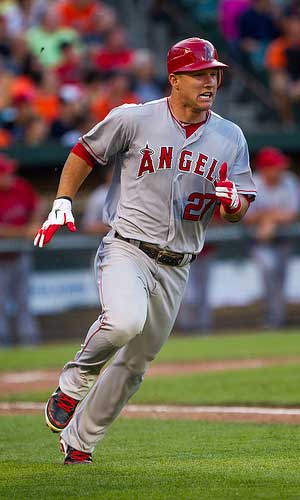Observe a high school or college-level baseball practice this summer and I'll bet you spend part of your time watching players jog along the warning track from foul pole to foul pole for what seems like forever.
Running poles is classic "low and slow" training that eats up valuable practice time and makes players slower and less explosive. I urge all of my baseball clients to eliminate poles, but old habits die hard. Here are the most frequent arguments (and my rebuttals) I hear:
Running poles is classic "low and slow" training that eats up valuable practice time and makes players slower and less explosive. I urge all of my baseball clients to eliminate poles, but old habits die hard. Here are the most frequent arguments (and my rebuttals) I hear:
#1: "It builds leg strength."
Low-intensity, slow-paced running does build leg strength, but only enough strength to run slowly. Stephen Kiprotich weighed 123 pounds when he won Olympic gold in 2012. He had the leg strength to run 26.2 miles in 2 hours and 8 minutes. He'd be really, really good at running poles.
Low-intensity, slow-paced running does build leg strength, but only enough strength to run slowly. Stephen Kiprotich weighed 123 pounds when he won Olympic gold in 2012. He had the leg strength to run 26.2 miles in 2 hours and 8 minutes. He'd be really, really good at running poles.
Mike Trout, one of the most explosive players in baseball, is 220-plus pounds and doesn't spend his time jogging the warning track. After finishing second in the MVP voting after his historic rookie season, he returned home to New Jersey and spent his off-season lifting weights (paying special attention to his lower body) and played basketball to stay in shape. I'd bet he can't keep up with Kiprotich running poles, but I'd take my chances with him at bat, on the bases or in the field.
#2: "It reduces arm soreness."
The day after a pitcher throws 100 pitches, he'll often do a long run "to break up the lactic acid built up in his arm from his outing to get rid of the soreness." I don't know who first communicated this theory, and I hope I never meet him.
First, the tasks performed during a baseball game are too anaerobic in nature to produce serious levels of lactic acid. Second, the muscle soreness players experience is muscular. Asking your arm to throw 100 high-intensity pitches produces muscle cell damage, and DOMS (Delayed Onset Muscle Soreness) occurs as the body repairs itself. Ice, massage, light stretching and rotator cuff exercises are all better ways to reduce soreness. Finally, long runs actually produce lactic acid, which only compounds the issue you're trying to resolve.
Aside from raising a player's heart rate and increasing blood flow, (which can be achieved in far more productive ways), running poles will do nothing for that sore arm.
The day after a pitcher throws 100 pitches, he'll often do a long run "to break up the lactic acid built up in his arm from his outing to get rid of the soreness." I don't know who first communicated this theory, and I hope I never meet him.
First, the tasks performed during a baseball game are too anaerobic in nature to produce serious levels of lactic acid. Second, the muscle soreness players experience is muscular. Asking your arm to throw 100 high-intensity pitches produces muscle cell damage, and DOMS (Delayed Onset Muscle Soreness) occurs as the body repairs itself. Ice, massage, light stretching and rotator cuff exercises are all better ways to reduce soreness. Finally, long runs actually produce lactic acid, which only compounds the issue you're trying to resolve.
Aside from raising a player's heart rate and increasing blood flow, (which can be achieved in far more productive ways), running poles will do nothing for that sore arm.
#3: It gets them "in shape."
In shape for what? If a hitter has to leg out a hit, he sprints for a matter of seconds, then stops. On average, pitchers make one throw at 100-percent intensity every 9 to 13 seconds. Baseball players perform multiple high-intensity tasks with enough time to recover between each rep. The heart rate spikes, then has time to return to nearly its resting rate. There is minimal aerobic endurance required to play the game at a high level.
If the outcome of tie games are ever decided by running a 5K, then I'll happily add distance running to my programs. Until then, I'll keep calling for lifting, sprinting and jumping instead.
In shape for what? If a hitter has to leg out a hit, he sprints for a matter of seconds, then stops. On average, pitchers make one throw at 100-percent intensity every 9 to 13 seconds. Baseball players perform multiple high-intensity tasks with enough time to recover between each rep. The heart rate spikes, then has time to return to nearly its resting rate. There is minimal aerobic endurance required to play the game at a high level.
If the outcome of tie games are ever decided by running a 5K, then I'll happily add distance running to my programs. Until then, I'll keep calling for lifting, sprinting and jumping instead.



I agree, Bryan. Players should practice the exact moves they'll performing during the game. For baseball players, interval training like a tabata would be beneficial.
ReplyDelete